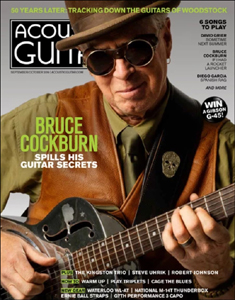19 July 2019 - Acoustic Classic: Bruce Cockburn’s ‘If I Had a Rocket Launcher’
In 1984, Bruce Cockburn scored an unlikely pop hit with “If I Had a Rocket Launcher,” which describes the Canadian singer-songwriter’s fantasies of violent retribution following a visit to a Guatemalan refugee camp that was regularly shelled by government helicopters. Cockburn originally recorded the song in a rock-band setting, flush with electric guitars and synths, but when he stopped by AG’s studios to film a private lesson last spring (see “Band in a Box” on page 20 of the print/digital edition), he stripped the song down to just guitar and voice.
The transcription on the following pages captures that performance note for note. At a glance, the notation might appear dense and complex, but you can make things easier on yourself if you break the song down and approach it systematically. You could play the first ten bars of the intro exactly as written, but it would be equally effective to improvise the natural harmonics. What’s most important here is the continuous eighth-note stream of open E notes—play them as firmly and evenly as possible, using palm muting if you’d like.

The heart of the song appears in bars 11–14. Riff A is the harmonic sequence for the subsequent verses and guitar solo, so be sure to spend plenty of time learning to play it with precision. In bars 11 and 13, maintain a barre across strings 3–5 at the seventh fret; grab the ninth-fret B and E with your third and fourth finger, respectively, or barre them both with either of those fingers. For the C6/9 chord in measures 12 and 14, keep your second finger stationed on the eighth-fret C and your first finger barred at the seventh fret, while stopping the tenth-fret G with your fourth finger.
In his off-the-cuff-feeling solo, starting at bar 45, Cockburn continues the eighth-note bass action established in the intro, above which he adds lines based mostly on 16th notes. Key to playing an effective solo here isn’t necessarily playing exactly what’s on the printed page but understanding how it works. The solo might sound intricate, but Cockburn is simply playing notes from the E natural minor scale (E F# G A B C D) entirely in seventh position—notes within easy reach of the chord shapes in the main riff. (For the lowdown on soloing with chord shapes, see Jeffrey Pepper Rodgers’ Weekly Workouts in the June 2017 and March 2018 issues of AG.) Be sure to put in the time studying this approach, as it will pay dividends for you in solo-guitar settings in general.
~from Acoustic Guitar.
Find this article and lots more in the September-October Editon of Acoustic Guitar Magazine
Due to copyright restrictions, we are unable to post notation or tablature for this musical work. If you have a digital or physical copy of the September/October 2019 issue of Acoustic Guitar magazine, you will find the music on page 60.